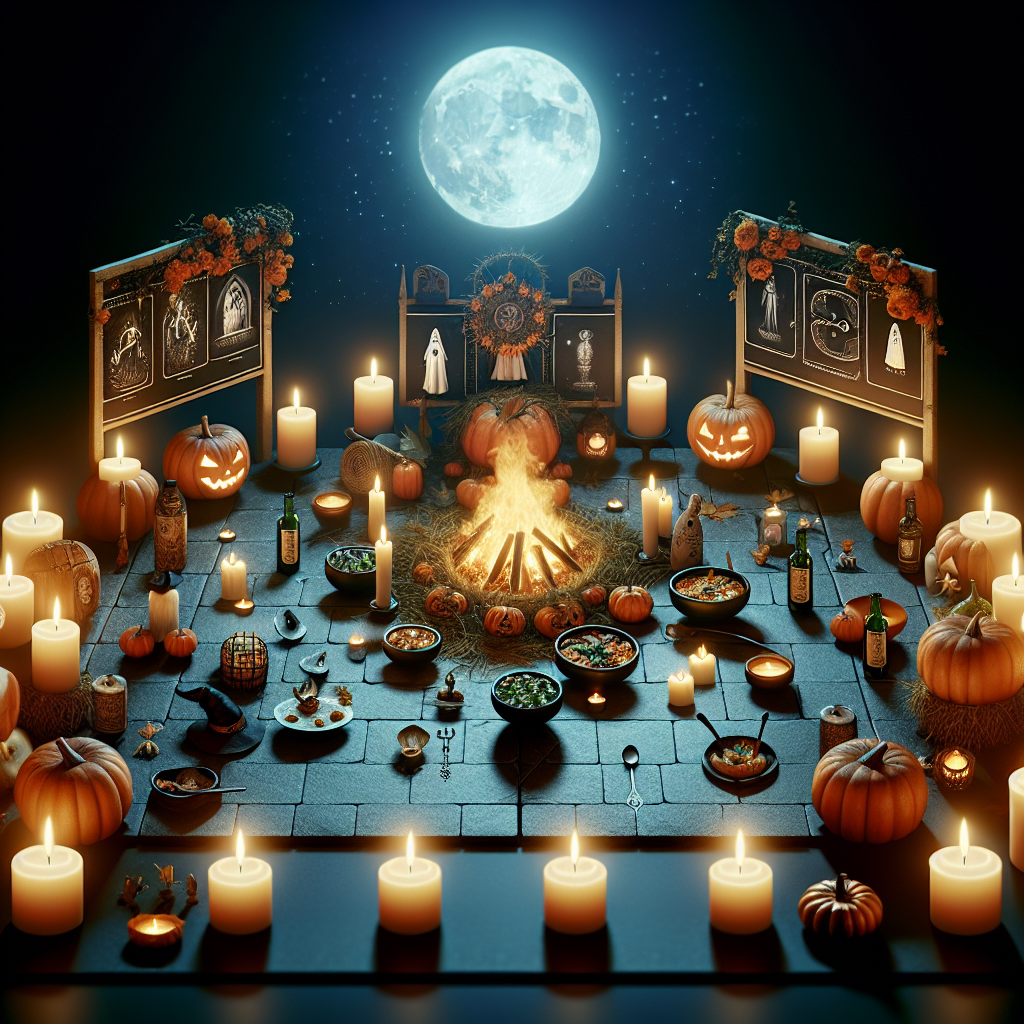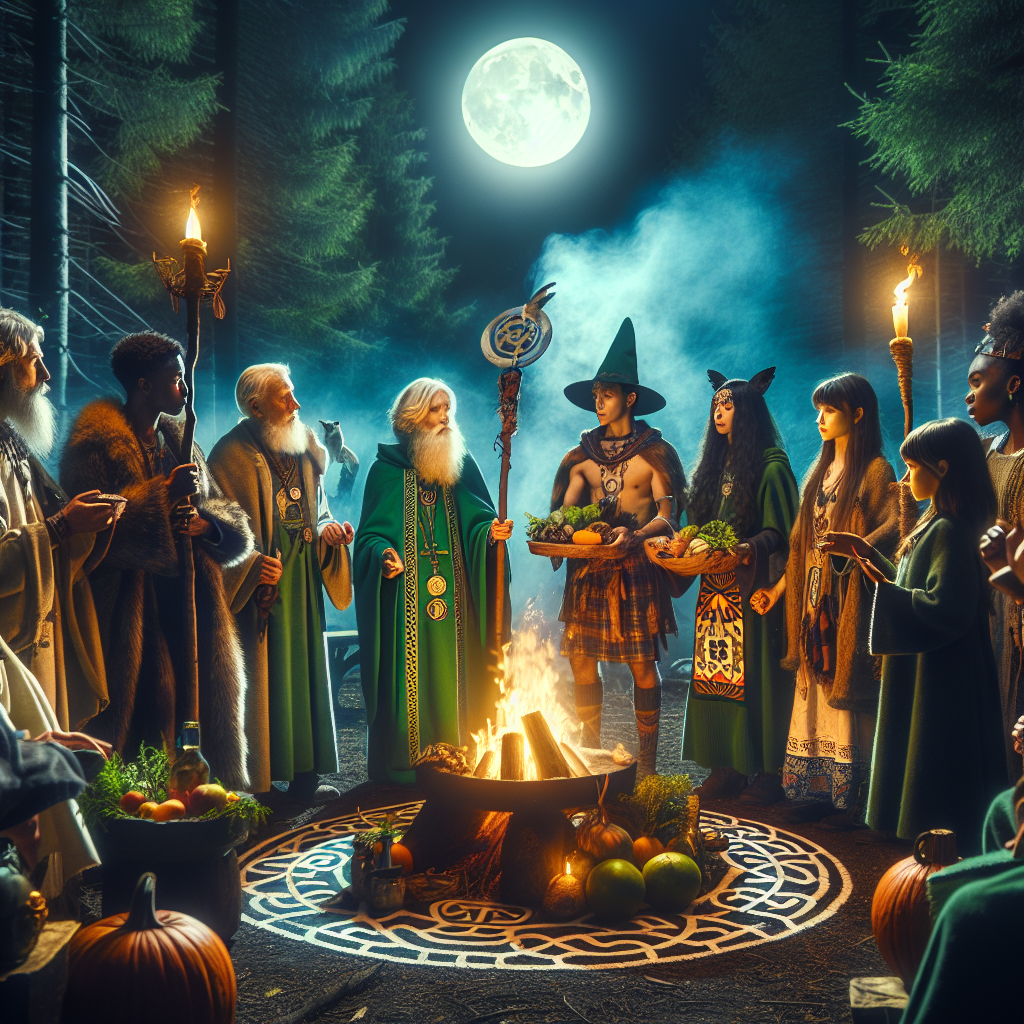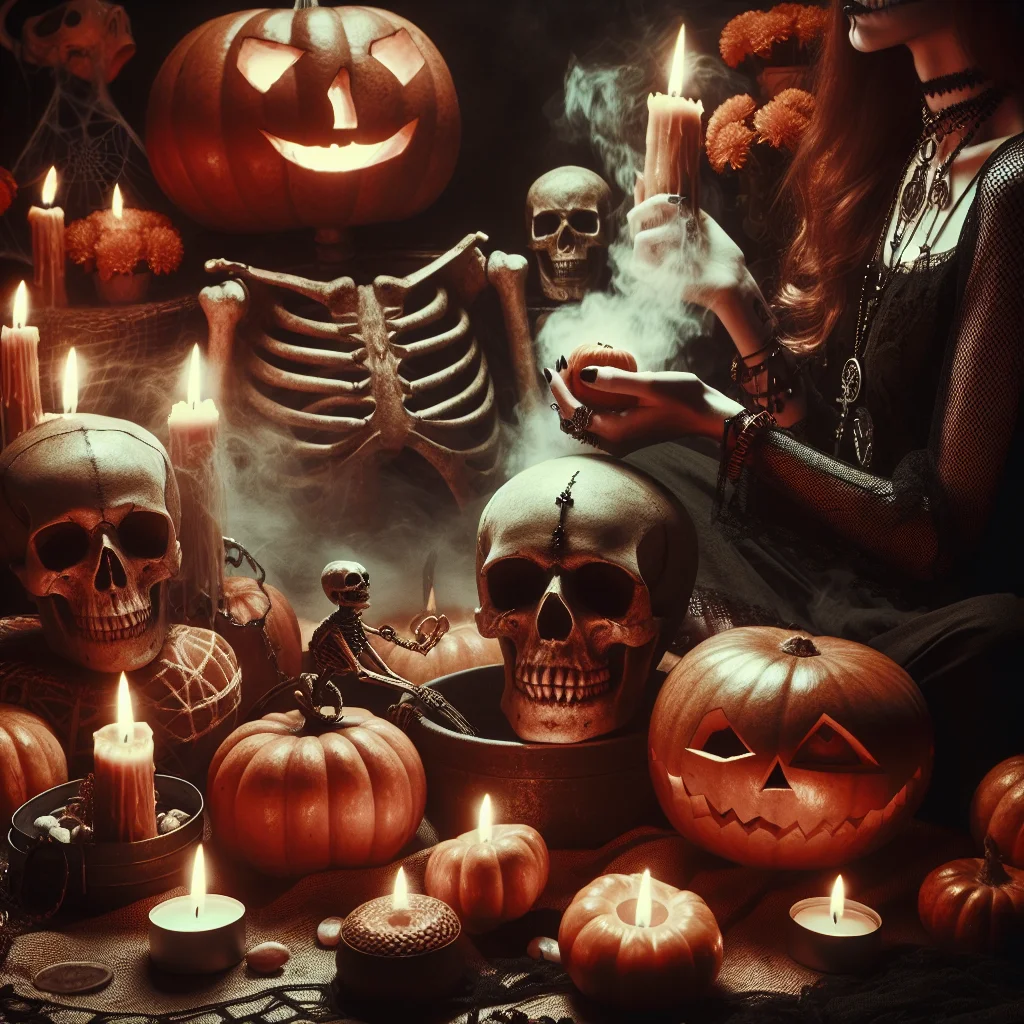As an Amazon Associate I earn from qualifying purchases.

Samhain, marking the end of the harvest season and the onset of winter, is a festival that has been celebrated for centuries, with roots deep in ancient Celtic tradition. Traditionally held on the night of October 31st to November 1st, this time of year is believed to be when the veil between the living and the dead is at its thinnest and the spirits are most present. Samhain is a time to honor ancestors and the beloved dead, a practice that continues to hold great significance for many modern spiritual and pagan communities.
Central to the celebration of Samhain is the Ancestor Altar, where photographs, heirlooms, or personal items belonging to the deceased are placed. This is more than a mere remembrance; it acts as a sacred space for inviting the spirits of the ancestors to return and join in the festivities. Candles are often lit to guide these spirits home and to represent the fire festivals of ancient Celtic tradition, which marked this turning point of the seasons.
One evocative practice is the “Dumb Supper,” a silent meal shared with the spirits. An extra place is set at the table for the deceased loved ones, and throughout the meal, there is an intentional silence to listen for messages from the spirits. This poignant ritual is a time of reflection and connection that transcends the boundaries of life and death.
The act of storytelling is another vibrant Samhain tradition, where tales of the ancestors are shared around a communal fire. This reinforces the familial bonds and passes down lessons and traditions from generations past. It is a time for both reverence and celebration, interweaving the power of oral history with the spiritual practice of honoring the dead.
Carved turnips, and today more commonly pumpkins, known as Jack-o’-lanterns, are not only a popular Halloween tradition but also part of ancient Samhain rituals. These carved lanterns with lit candles inside are thought to ward off evil spirits or, alternatively, to light the way for good spirits to visit the living during Samhain.
Making offerings is a central part of Samhain rituals, which involve leaving out food and drink for the dead. This can include “soul cakes” or other traditional fare that might have been favored by the deceased. The offerings are meant to appease the spirits and provide sustenance for their journey from the spirit world.
As a deeply reflective time, Samhain is also opportune for divination practices and seeking insight from ancestors. Tarot readings, scrying, and rune casting are just a few of the methods practitioners may use to gain guidance or understandings that are believed to be more accessible during this liminal time.
The custom of wearing costumes, now synonymous with Halloween, has its roots in Samhain as well. Originally, these disguises were worn as a means of protection, to ward off any malevolent spirits that might cross over during the night. They were also a way to embody various spirits, deities, or even the souls of the dead themselves in a form of ritual enactment.
A lesser-known ritual involves placing a wooden cross at the graves of loved ones, symbolizing the four quarters of the Celtic calendar and the protection of the spirits on their journey. This simple act is a beautiful gesture of reverence and remembrance, often accompanied by the recitation of prayers or poems.
Planting a tree in remembrance of the deceased is a Samhain custom that adds a living tribute to the landscape. As the tree grows, it stands as a symbol of the enduring spirit of the loved ones who have passed on, as well as a testament to the cycle of life, death, and rebirth.
Finally, the tradition of ringing a bell on Samhain is both a protective measure and a means of communication with the spirit world. The sound is said to clear negative energies, purify the space, and signal to the spirits that their loved ones are present and ready to commune with them. This sonic element adds another layer to the multisensory experience of Samhain festivities.
By engaging in these rituals and others, participants of Samhain not only honor those who have come before them but also foster a sense of continuity with the past, present, and future. These time-honored traditions bridge the gap between the living and the dead, creating a shared celebration that is as much about community and heritage as it is about the spiritual connection to those who have passed away.
Samhain, traditionally celebrated from October 31st to November 1st, marks the end of the harvest season and the beginning of winter in the Celtic calendar. It is a time when the veil between the worlds of the living and the dead is believed to be thinnest, making it an ideal moment for honoring ancestors and deceased loved ones. Here are 15 Samhain rituals that can help you connect with and honor the dead:
1. **Light a Candle in Remembrance**: Lighting a candle is a simple yet powerful gesture. Choose a candle to represent each deceased loved one, and as you light it, say their name aloud and recall a fond memory or share a message of love.
2. **Create an Ancestor Altar**: Set up a small table with pictures of your ancestors, heirlooms, and other items of sentimental value that remind you of those who have passed. This can serve as a sacred space for reflection during Samhain.
3. **Share a Silent Supper**: Prepare a meal and set a place at the table for those who have departed. This “dumb supper” is eaten in silence, allowing participants to contemplate and feel the presence of their ancestors.
4. **Visit Gravesites**: Visit the resting places of your ancestors or lost loved ones. Tend to the sites, perhaps leaving flowers, cleaning headstones, or placing stones on the grave in remembrance.
5. **Write Letters to the Dead**: Write letters expressing anything left unsaid to deceased loved ones, then burn them in a fire, releasing the messages to the spirit world.
6. **Telling Stories**: Gather with family or friends and share stories of ancestors and departed loved ones, keeping their memories alive through the power of narrative.
7. **Divination Practices**: Use tools like tarot cards, pendulums, or runes to seek wisdom from the spiritual realm. Be open to messages that might come from the other side.
8. **Take a Nature Walk**: Connect with the cycles of life and death by walking in nature. Reflect on the beauty of life and the peacefulness of life’s transitions.
9. **Toast to the Dead**: Raise a glass in honor of the dead. Speak their names and achievements as you toast, celebrating the impact they had on your life.
10. **Spirit Plate Offering**: Prepare a plate of food specifically for the spirits, placing it outside, on the ancestor altar, or in another significant location.
11. **Samhain Meditation**: Spend time in quiet meditation, focusing on your ancestors. You may sense their presence or receive intuitive guidance during this time of contemplation.
12. **Craft a Wreath**: Create a wreath filled with symbols of the season such as acorns, pine cones, and pomegranates, weaving in your intentions to honor the dead.
13. **Pumpkin Carving**: As a nod to the ancient traditions of carving turnips to ward off evil spirits, carving pumpkins can be a creative way to honor the deceased. Perhaps design a carving that has a special meaning for you and your loved ones.
14. **Ritual Bonfire**: Bonfires are a traditional part of Samhain rituals. Write down what you wish to release from the past year and toss it into the flames, inviting ancestors to join you in letting go.
15. **Ringing of the Bells**: Ringing bells is thought to comfort spirits and clear away negative energy. Ring a bell to guide and soothe the spirits on their journey.
Participating in Samhain rituals can deepen your connection to your ancestors and provide a space for personal reflection and healing. While the physical presence of lost loved ones may be absent, many believe that their spiritual essence is more accessible during Samhain.
Interestingly, a statistic indicates that a significant number of people who participate in Samhain traditions find comfort and closure in the process, with an increasing number of people incorporating ancestral veneration into their modern spiritual practice. This demonstrates the enduring legacy and relevance of ancient traditions in contemporary spiritual life.
- What is Samhain and why is it associated with honoring the dead?
Samhain is an ancient Celtic festival traditionally celebrated from October 31st to November 1st, marking the end of the harvest season and the beginning of winter. It is associated with honoring the dead because the Celts believed that during Samhain, the veil between the living and the spirit world was at its thinnest, allowing for easier communication with deceased loved ones and ancestors.
- Is Samhain the same as Halloween?
No, Samhain is not the same as Halloween, although Halloween has its roots in Samhain traditions. Halloween, celebrated on October 31st, has evolved into a secular holiday with various customs like trick-or-treating and costume-wearing, whereas Samhain is a spiritual observance that focuses on the cycle of death and rebirth.
- Can anyone participate in Samhain rituals or do you need to be of Celtic heritage?
Anyone can participate in Samhain rituals; you do not need to be of Celtic heritage. Many modern pagans, Wiccans, and spiritual practitioners observe Samhain rituals as part of their belief systems or as a way to connect with their ancestors and the spirit world.
- Are Samhain rituals safe to perform at home?
Yes, Samhain rituals are generally safe to perform at home as long as you follow basic safety guidelines, particularly when working with candles, incense, or open flames. It’s important to create a safe and respectful environment for any spiritual practice.
- Do I need any special tools or items to perform a Samhain ritual?
While there are traditional items often used in Samhain rituals such as candles, incense, photographs of loved ones, and offerings, you do not necessarily need special tools or items. The most important aspect is the intention behind the ritual. You can adjust the rituals to suit the materials you have available.
- Are there any specific prayers or words that should be said during Samhain rituals?
There are no mandatory prayers or words, but many choose to recite poems, blessings, or specific invocations that honor the dead and the cycle of nature. You can write your own or use traditional Samhain prayers found in pagan literature.
- Can children participate in Samhain rituals meant for honoring the dead?
Yes, children can participate in Samhain rituals with adult guidance. It can be a way to teach them about cultural traditions, the importance of honoring ancestors, and the natural cycle of life and death in an age-appropriate manner.
- Is there a community aspect to Samhain, or is it typically an individual practice?
Samhain can be observed both individually and as a community. Some practitioners prefer solitary rituals, while others gather in groups or attend public ceremonies. Community rituals often include shared feasts, dancing, and collective remembrances of the ancestors.
- What kind of offerings are appropriate to leave for the dead during Samhain?
Traditional offerings include food, drink (often wine or cider), and personal items that belonged to the deceased or that the dead once favored. The offerings can be left on altars, buried, or placed outdoors.
- How can I ensure that my Samhain ritual is respectful to various cultural traditions surrounding death?
Research and understand the origins and meanings behind the Samhain rituals you plan to perform to ensure cultural sensitivity. Approach the practices with respect, and avoid appropriating aspects of cultures that are not your own. Additionally, you can adapt rituals to honor your specific cultural background and the traditions of your ancestors.

Conclusion
Throughout the collection of 15 Samhain rituals for honoring the dead, it becomes evident that these practices serve as a deep-rooted cultural bridge connecting the living with their ancestors. Whether through the silent supper, where a place at the table is set for the departed, or by lighting candles to guide spirits back to the realm of the living, each ritual carries its own significance and allows participants to pay their respects in a meaningful way. These practices reflect the importance of remembrance and the belief in the continuity of the spirit. By carving Jack-o’-lanterns or creating altars with offerings, the living engage in age-old traditions that not only honor those who have passed but also affirm the spirituality inherent in the cycles of life and death.
The variety of Samhain rituals, from reflective solitary practices to community gatherings, signifies the diverse ways in which individuals and societies can connect with the spirit world. The act of storytelling, for instance, serves as a powerful means of preserving the memories and wisdom of the deceased, while bonfires and feasts foster communal bonds among participants. Such rituals do more than commemorate the dead; they provide a space for introspection, healing, and renewal. As we observe these traditions, we are reminded that honoring the dead during Samhain is a poignant testimony to the enduring relationship between the earthly existence and the afterlife, echoed in the changing seasons and the natural world.
Amazon and the Amazon logo are trademarks of Amazon.com, Inc, or its affiliates.


